
|
History of Sex in Cinema: 1962-1963 |
| Movie Title/Year and Film/Scene Description | ||||||||||||||||||||||||

|
Advise & Consent (1962) This complex and controversial drama about party politics with a big-name cast was directed by Otto Preminger. It was based upon Allan Drury's highly influential and best-selling, Pulitzer Prize-winning political potboiler of 1959. The movie was both praised for its daring homosexual subplot and also condemned for its datedness. In one scene, it stereotypically portrayed a NYC gay bar (Club 602) with the voice of Frank Sinatra singing on the jukebox and the effeminate bartender beckoning for a horrified homosexual character to enter. The plot was about the US President's (Franchot Tone) nomination of Robert A. Leffingwell (Henry Fonda) to the position of Secretary of State. The President's appointment was supported by Senate Majority Leader Bob Munson (Walter Pidgeon), but was opposed by southern Senator Seabright Cooley (Charles Laughton), who was branding Leffingwell as a left-wing, former Communist Party member. In fact, Leffingwell had admitted his youthful indiscretion to the President, but when testifying under oath before the Senate subcommittee, he denied the accusation. Stringently honest, idealistic and principled Utah Senator Brigham Anderson (Don Murray) was the head of the Senate nominating sub-committee. The controversial candidate's fate was ultimately in his hands, when he learned of the perjury and demanded that Leffingwell's nomination be withdrawn. However, the President refused, and Anderson was faced with making the truth public. Then it was revealed that Senator Anderson also had a "nasty secret" from his own past. His secret was that late in World War II during R&R in Hawaii, he had engaged in a month-long affair with another serviceman. He tried to hide the fact of his latent homosexuality from his wife Ellen (Inga Swenson) who was receiving anonymous telephone calls. She asked her husband about an "awful creature on the phone" who made it sound like he knew some kind of a "nasty secret." Anderson was threatened with blackmail by Senator Fred Van Ackerman (George Grizzard) - who knew of Anderson's own past indiscretion. Unable to face his own past, Anderson tragically committed suicide - he "cut his throat" (slashed his own throat with a razor). As it turned out, the vote on the controversial nomination was deadlocked. And then the President died, and the Vice President-elect (Lew Ayres) announced that he would appoint his own Secretary of State. |
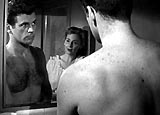 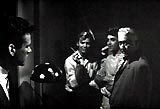 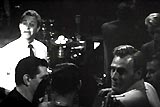 |
||||||||||||||||||||||
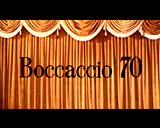
|
Boccaccio '70 (1962, It.) This four-part anthology film about Eros was made by great Italian directors. The four segments and their major stars included three sexy European stars: Romy Schneider, Sophia Loren and Anita Ekberg:
The most interesting episode was Federico Fellini's Le Tentazioni del Dottor Antonio (The Temptations of Dr. Antonio), Fellini's first film in color.
The segment told about a milk company's advertisement in the form of a giant billboard in a Rome park that provocatively pictured a reclining, well-endowed blonde bombshell Anita Ekberg (playing Herself). She entreated passersby to "Drink More Milk." Surprisingly, she suddenly came alive to torment and tempt self-appointed moral protector Dr. Antonio Mazzuolo (Peppino De Filippo), a pious and crusading censor who wished to cover up or dismantle the billboard, believing that it was the cause of corruptive evil in the world. He prayed to himself:
Then she laughed at him, set her large milk glass on the ground near him, and stepped out of the photo ("I'm alive"). In her Amazonian 50-foot size, she ran through the grass, rolled around (causing the earth to tremble), and then stalked him. She asked: "Why are you so nasty to me?" and "Does it bother you that you're so small?" She promised: "I won't hurt you. I'll just caress you." She picked him up, and placed him between her monstrous breasts as he screamed: "What an embarrassing place to die." When he reached for his umbrella in her cleavage, she teased him: "Mr. Mazzuolo likes touching!" She then changed into normal size, and caused him to fall for her: "Stay with me, forever...You're so beautiful. Don't be nasty, stay with me," he begged, but then immediately changed his mind and chastised her. Growing in size again, she yelled at him: "I'm fed up with you." She realized the power of her allure as she began to strip-tease. She claimed she was the devil, there to take him away, and asked: "Help me get completely undressed." He attempted to cover the camera lens, to obscure the offensive views of her by women and children in the cinema. She asked as she lowered her dress top (offscreen):
As he speared the billboard pretending that he was St. George killing the dragon, it appeared that the entire encounter with her had been his own internal crazed fantasy. He was sedated and carried away on a stretcher to an awaiting ambulance. |
|
||||||||||||||||||||||

|
Cape Fear (1962) This suspenseful and intense late b/w film noir featured the sexually-predatory character of vengeful, amoral and insolent psychopath Max Cady (Robert Mitchum) (often with a thick phallic cigar on his lips and wearing a Panama hat). He was a disgruntled ex-convict who relentlessly pursued the members of the family of well-regarded Southern lawyer Sam Bowden (Gregory Peck). Cady believed that Bowden had wrongfully witnessed against him earlier in Baltimore eight years (four months and 13 days) for a vicious rape and assault. While waiting for his chance to rape again, the sexually libidinous ex-criminal picked up a floosy-drifter named Diane Taylor (Barrie Chase) from a waterfront bar scene after he undressed her with his eyes. She later cheerfully described him as an animal: "coarse, lustful, barbaric." He replied: "Keep right on talkin', honey. I like it when you run me down like that." She called him "rock-bottom" and added: "It's a great comfort for a girl to know she could not possibly sink any lower." But then in a cheap second floor hotel room, he circled her bed and predictably committed acts of "lewd vagrancy" and assault upon her, and she was found with a bruised face. However, she refused to answer questions, press charges or seek treatment and promptly fled from town. She feared recrimination: "Nobody can protect themselves against a man like that." At a boat dock, Cady lewdly made a comment to Sam about his young teenaged daughter Nancy Bowden (Lori Martin):
After Nancy's school dismissal one day, he lustfully stalked her into the school's basement, terrorized her and almost killed her when she ran into the street. The "shocking degenerate" told Sam how he had threatened his own ex-wife (now married to a plumber) after being released from prison (where he had "burned for eight years"), forcing her to write a "love note" to him inviting him on a "second honeymoon" -- "I made her write a lot of dirty words. Then I occupied her time for three days." On a Cape Fear River houseboat where Sam had lured Cady with the two females as 'bait,' the bare-chested ex-con first threatened wife Peggy (Polly Bergen) to have consensual sex with him in order to spare her daughter. He angrily squeezed a raw egg in his fist over her and rubbed the insides over her chest as he told her:
When she claimed he was using sexual blackmail on her, he held her against a wall, slapped her, and forced her to keep quiet: "All in all, I don't think you're gonna, you're gonna say too much about this, are you?" His assault of Peggy was only a diversion to go after Nancy, and although the young girl defended herself with a fireplace poker, she was no match against his powerful grip - he gagged her mouth and dragged her outside, where she was ultimately saved by her father. |
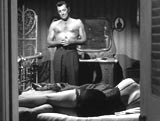  Max Cady with Diane Taylor (Barrie Chase) 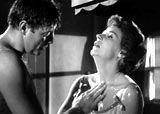 Max with Peggy (Polly Bergen) 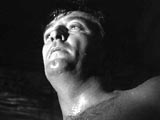 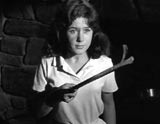  Max with Nancy (Lori Martin) |
||||||||||||||||||||||

|
Dr. No (1962, UK/US) The Bond films with Bond Girls told about a promiscuous agent who practiced casual 'free love' in an atmosphere of action and violence. As in most of the films, Bond would defeat the villain(s) and get the girl. In the film's most unforgettable sequence of Dr. No (1962), Bond awakened to the sound of a girl's voice singing "Underneath the Mango Tree." And then on the Crab Key beach rising Venus-like from the water with giant seashells that she was poaching, Bond had his first view of Honey Ryder (Ursula Andress), an innocent, carefree, voluptuous island girl/diver wearing a sexy, white bikini and hunting knife at her waist.
Bond's own appearance from the undergrowth startled her:
Later, Bond rescued strapped-down Honey from a flooding sluice-gate chamber, and they safely escaped Crab Key in one of villainous Dr. No's boats - that conveniently ran out of fuel and sent them drifting. He suggested: "We can swim, or come here..." When they were located by Leiter in a rescue boat, they had this exchange of conversation (similar one-liner and double-entendres were commonplace in Bond films):
Soon, they were given a tow back to shore by the rescue boat, although Bond released the tow-line to let them go adrift and continue embracing and kissing. |
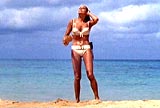 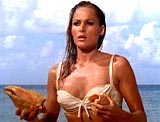  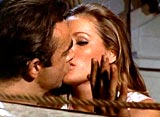 Honey Ryder (Ursula Andress) |
||||||||||||||||||||||

|
Gypsy (1962) This screen version of the 1959 Broadway musical play (starring Ethel Merman) by Warners, with a Jule Styne-Stephen Sondheim score, was suggested by the lives of:
Gypsy's debut stripping stageperformance (with a deeply sensual subtext) of Let Me Entertain You was while she was wearing long white gloves and an elegant blue evening gown. She was introduced as "Gypsy Rose Lee," and she made a nervous appearance on stage before an all-male audience, as Mama stood and coached off-stage and yelled tips. She used her Mama's vaudeville trademarks, teasingly removing a long white glove as she asked the audience: "Hello everybody, my name is Gypsy! What's YOURS?"). She then dropped the strap on her evening gown, and teasingly offered: "We'll have a real good time." One of the memorable numbers was the wild You Gotta Have A Gimmick performed by a trio of Minsky's burlesque house strippers (Roxanne Arlen, Betty Bruce and Faith Dane) to Louise Hovick - aka Gypsy Rose Lee - on how to be an innovative stripper. There was also a montage of future performances, exhibiting Gypsy's significantly improved stage show with a deeply sensual subtext, more stylish peekaboo stripping and costuming, and her trademark line to the audience: ("Hello everybody, my name is Gypsy! What's YOURS?"). The montage ended with Gypsy's introduction at Minsky's - headlined by "The Queen of Striptease" who again performed: "Let Me Entertain You" - "We'll have a real good time!" - and gave a semi strip-tease behind a curtain. |
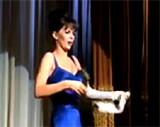  Gypsy Rose Lee (Natalie Wood) |
||||||||||||||||||||||
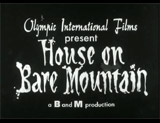
|
House on Bare Mountain (1962) Independent film director Director R. Lee Frost made this early, hour-long 'nudie-cutie' sexploitation film - meaning lots of breasts and buttocks on display, no touching or actual sex, and no full frontal views. It enticed with the come-on: "Everything's Off! When the Hollywood Models Meet the Monsters." Shot in Nuderama! Monsters Meet 20 Lovely Models. Old lady Granny Good (Bob Cresse in drag, resembling comic Jonathan Winters' Granny Maude Fricker character at the time) was running a girls' "finishing" school (GGSFG) for female teens (actually older women) in a "vine-covered cottage" (actually a horror film mansion), although in the first scene, the transvestite was seen behind bars. The story was told in flashback -- in the opening scene, Granny (after hiding numerous liquor bottles in his office) met with the parents of a new student named Prudence Bumgartner (Laura Eden) for entry into the school. Bombs exploded nearby (exploding bottles of moonshine!). It was soon revealed that they were undercover cops searching for evidence to arrest Granny. During the interview, one of the shapely students, Honey (Angela Webster), entered topless and wearing only white panties. She had been studying nuclear physics and was then given the task of memorizing the entire dictionary. Prudence was assigned Sally (Ann Meyers) as her roommate, and soon the entire floor of girls was undressing and showering.
Most of the activities of the school were led by Granny ("Let's shake 'em up!...the Sag, Straddle, Hop"), with the girls in the nude, showcasing lots of mobile breasts: exercising outdoors included jumping jacks, twisting, and skipping rope. They also studied in a drawing class (with Granny as their model) and after lunch, they recessed by sunbathing in the sunshine and tossing a beach ball by the pool.
Due to financial difficulties, Granny had employed Krakow (William Engesser, also crazy-credited as Abe Greyhound), a huge 7 foot tall, non-speaking (besides grunts and growls) hairy werewolf, to operate an illicit moonshine still in his cellar. Granny was suspicious that someone was attempting to rat him out to the authorities. In the film's climax, a fancy annual costume ball was scheduled (during a full moon) for the girls. Before the party, there was a long sequence of girls (one-by-one) descending the stairs (topless) to make phone calls to their boyfriends, reminding them to bring alcohol. Right at the beginning of the boring party, Prudence contacted police by walkie-talkie, urging them to come and bust the illegal cellar still during the celebrations, but then she was confronted by Krakow in the cellar - and she passed out. The punch was spiked multiple times by the costumed monsters at the party (Frankenstein (Percy Frankenstein), and Dracula (Doris Dracula) and by Granny himself. After the cops arrived, they arrested Granny in the cellar - where she offered to have them sample her "elderberry wine" - causing them all to collapse to the floor. Meanwhile, the booze-soaked party upstairs had become a well-behaved dance orgy with many female students doffing their tops to wriggle around - doing the Watusi or Twist.
In the surprise ending, Granny wasn't in jail, but all of the cops were - after becoming drunk and imprisoned in his cellar. Krakow had been liberated from his 13 cents a day job by a representative from the United Werewolfs of America organization. Left without a worker, Granny cracked his whip to get the officials (accompanied by Prudence) to distill more booze. |
 Granny Good (Bob Cresse)  Showering   Jumping Rope  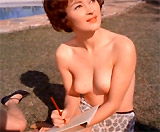 Drawing Class  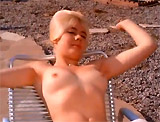 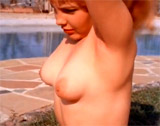 Sunbathing |
||||||||||||||||||||||
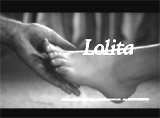
|
The original 1962 Kubrick version of Vladimir Nabokov's novel, Lolita (1962) was a dramatic story with black humor of juvenile temptation and perverse, late-flowering lust. It told the basic plot line of the obsessive love of a mature literature professor for a pubescent nymphet (12 years old in the original novel) in an aura of incest. During the film's production, however, it was marked by the threat of censorship and denial of a Seal of Approval from the film industry's Production Code.
Rather than a film of overt sexuality and prurient subject matter, the content of the 1962 version was mostly suggestive, with numerous double entendres and metaphoric sexual situations. The film's publicity posters asked the tagline: "How did they ever make a movie of Lolita?" with a picture of Lolita in a seductive lollipop pose. She wore heart-shaped sunglasses and licked a red lollipop. Indeed, at the time of the film's making, sexual freedom and content had not advanced to the point of acceptance commonly seen today. Lolita's opening credits, however, contained some of the most overtly-erotic, idealizing images of the entire film - designed to set the tone of the film. They hinted at pedophilia during a pedicure (during which the over-controlling and possessive male protagonist expressed sexual jealousy).
The first view of nubile, young, sultry twelve-year-old daughter, Dolores 'Lolita' Haze (Sue Lyon - a fourteen-year-old television actress in her screen debut) was as she languidly sunbathed on a blanket on her backyard's garden lawn, listening to a transistor radio. The tempting, precocious, iconic, underaged nymphet was wearing a two-piece bathing suit and wide-brimmed sun-hat, and eyed by the passion of middle-aged professor Humbert Humbert (James Mason). Lolita's mother Charlotte (Shelley Winters) tempted him to board in their home with her "cherry pies." A shorthand montage of images and scenes visually provided a metaphor of Humbert's growing obsession for the young girl - he competed with Lolita's affection as Charlotte continued to show interest in him. But when it was announced that Lolita would be attending summer camp two hundred miles away, Humbert's face suddenly expressed understated consternation at the thought of Lolita's departure. She hugged him in the upstairs hallway before leaving. To be near Charlotte's seductive child so that he could proceed with his nymphetomania, Humbert realized that he must marry Charlotte. Opportunely, Charlotte was killed when she ran out of the house and into the path of an oncoming automobile in the street, before revealing Humbert's secret obsession with her daughter. Humbert, now Lolita's official guardian, drove the Haze station wagon to pick her up from summer camp. The aptly-named camp sign welcomed him: "CAMP CLIMAX FOR GIRLS - Drive Carefully." He was reluctant to tell Lolita the truth about her mother's death. He confessed his love for the not-so-naive Lolita:
The film was noted for the scene of Humbert's overnight stay at a hotel with Lolita, where he willingly accepted the only room available for his planned 'seduction' - Room # 242 - "it's only got one bed." Although he contemplated crawling in bed with Lolita, he was resigned to sleeping alone on a rollaway cot. The next morning, she gave him a coquettish, whispered suggestion to play a game that she had learned at camp with a boy named Charlie, while seductively twirling the hair on his head with her finger --- followed by a discrete fade to black. About four years later, it was revealed that Lolita had gone through "much sadness and hardship." She was married, six months pregnant, and in debt when Humbert visited to help support her financially. Lolita was very unlike the sultry, sleek young girl he had remembered a few years earlier. She admitted to having had a continuing affair with another of the film's prominent characters, TV writer Clare Quilty (Peter Sellers), another pedophile. Tragically, Lolita had been robbed of her childhood and youth by both Humbert's affections and Quilty's exploitative, sordid relationship with her. In the film's epilogue, Humbert's car drove headlong into the fog toward Quilty's mansion - he was insanely motivated to commit murder for Quilty's duplicity and his part in seducing, running off and abandoning Lolita. Also, "Humbert Humbert died of coronary thrombosis in prison awaiting trial for the murder of Clare Quilty." |
  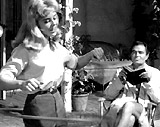 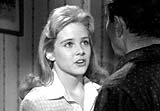  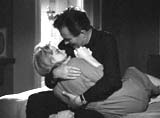 Lolita (Sue Lyon) with Humbert (James Mason) |
||||||||||||||||||||||

|
Something's Got to Give (1962) This light romantic comedy was famous for containing the last role (although uncompleted) of sex star Marilyn Monroe. Production delays and the expense of Fox's epic Cleopatra (1963) resulted in the firing of Marilyn, although she had been re-hired and was to resume production in October of 1962. It was to be considered her come-back film. Then the film was permanently halted when Monroe died of a drug overdose on August 5, 1962 at the age of 36. She had taken the role of married Ellen Wagstaff Arden. The most highly-anticipated scene, which would have been the first nude scene in an American sound film by a major star, was a well-publicized nude swimming pool scene.
Due to Marilyn's death, the nude star honor would then be held by Jayne Mansfield for her naked appearance in Promises... Promises! (1963) - see below. The production of Something's Got to Give was revamped and remade as Move Over Darling (1963), starring Doris Day - and without nudity, of course. |
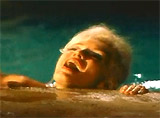  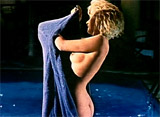 Ellen (Marilyn Monroe) |
||||||||||||||||||||||
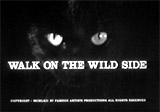
|
Walk on the Wild Side (1962) Director Edward Dmytryk's melodrama (based on Nelson Algren's 1956 novel of the same name) was considered a shocking film (for its time). It was notable as the first major Hollywood film to be open about the subject of lesbianism even while restrictions were being imposed by the Production Code, but it was harshly criticized as lewd, tawdry, and sleazy. Its Oscar-nominated title song had the tagline: "Love is Best When Kept a Secret," alluding to the film's seedy underworld plot set in Depression-Era New Orleans. The hookers at the Doll's House bordello (more opulent in the film than in the novel, with a jazz band and a bar) were managed by lecherous, iron-willed, villainous lesbian madame Jo Courtney (Barbara Stanwyck - the first US actress to portray a lesbian in a feature film), who was sexually disinterested in her disabled husband. Prostitutes working at the brothel included:
Anne Baxter portrayed Mexican café owner Terasina Vidaverri who allowed Dove to stay and work on the outskirts of New Orleans, while he searched for (and finally located) Hallie. Jo was possessively in love with her own employee, Hallie, and in the film's most homoerotic scene, Jo tried to intimidate her when Hallie expressed a desire to marry Dove, her true love in Texas from four years earlier, and run off with him:
In fact, Hallie broke Dove’s heart when he learned she was a prostitute living a "life of sin," but he forgave her and still vowed to rescue her. The lustful Kitty was vengefully involved in a plot to betray and blackmail Dove into leaving Hallie forever. Also, Jo had Dove severely beaten.
By film's end, Hallie suffered for her perverted profession (according to Production Code dictates) - she was accidentally shot in the stomach when the gun of Jo's bodyguard Oliver (Richard Rust) went off during a struggle with Dove in Teresina's cafe and she died in Dove's arms. |
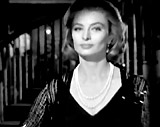 Hallie (Capucine) 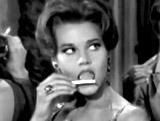 Kitty Twist (Jane Fonda) 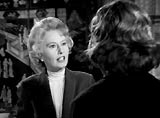 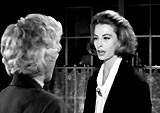 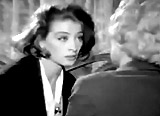 Jo Courtney (Barbara Stanwyck) and Hallie |
||||||||||||||||||||||

|
Wild Gals of the Naked West (1962) Russ Meyer's lesser comedy film advertised itself as "A SINtillating, titillating, rollicking, raucous, romp through the wild & swinging West." It was the skin-flick director's third feature - and the final one in his trilogy of color 'nudie-cuties,' beginning with The Immoral Mr. Teas (1959) and Eve and the Handyman (1961). The silly western spoof film (basically a nickelodeon-styled silent film without synchronized sound) opened with a lengthy narration about the epic old west (with panning shots of sagebrush, western landscapes, bloody swords and bugles).
It then consisted mostly of short vignettes, recalled and narrated by a prospector (Werner Kirsch) with fake white cotton whiskers and eyebrows, about how an old western ghost town was formerly filled with decadence and debauchery, evidenced by larged breasted topless women (with pasties) shaking their assets, amidst shooting guns and drunken coots guzzling whiskey straight from the bottle while grinning at the camera.
The plotless film concluded with the arrival of a maroon-clothed Stranger (Sammy Gilbert) with a foot-long silver pistol and blue-colored hat who vanquished the grizzly, black-clad bad guy named Snake Wolf (Frank Bolger) to claim the big-breasted heroine Goldie (or Golden Nuggets) (Terri Taylor), and join her behind a "DO NOT DISTURB" sign. |
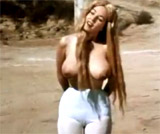 Girl at the Stake   Bathing Outdoors |
||||||||||||||||||||||
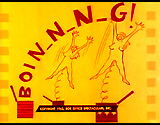
|
Boin-n--n-g! (1963) Director Herschell Gordon Lewis' soft-core "nudie cutie" (made with producer David F. Friedman) was one of the last of its kind. It was a self-satirizing and semi-autobiographical screwball comedy about the sexploitation film industry itself ("The Howlarious Story of 2 Guys Who Make a Nudie Movie"). It advertised that the film featured "undraped damsels by the dozens." It told about two amateur porn film fanatics who were interested in making their own porn film:
After watching the Herschell Gordon Lewis double feature: Daughter of the Sun (1962) and The Adventures of Lucky Pierre (1961) at the Studio Theatre, the two inexperienced filmmakers decided to audition and film naked women for an adults-only nudie movie of their own making. They hired film equipment, auditioned a few females, and rented out a country cottage for the weekend's filming in the outdoors. They titled their film "Nature's Nudniks," but there were disastrous results and complications. In one segment, the nude actresses sat down in poison-ivy! |
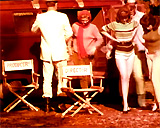 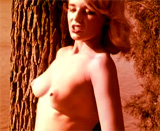 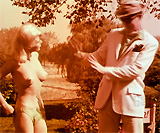 
|
||||||||||||||||||||||

|
Cleopatra (1963) This epic 4-hour blockbuster from 20th Century Fox was heavily publicized for many reasons:
In the long run, the publicity was beneficial for the film's bottom line, since it needed to recoup its expenses when it was finally released. The stars' off-screen indiscretions helped (although they were criticized on moral grounds), but it took many years for the film, the most expensive to date, to recoup its enormous costs.
Besides appearing nude under a massage towel or a diaphanous lounging gown, and often seen in bosom-revealing gowns, Cleopatra (Liz Taylor) had numerous love scenes with both co-stars - first with Julius Caesar (Rex Harrison) and then Marc Antony (Richard Burton). When Caesar took her as his mistress, because his wife Calpurnia was barren, Cleopatra placed his left hand on her right breast to successfully seduce him:
She bore him a son named Caesarion. In the magnificently-staged reception that Caesar held for the Queen of Egypt in Rome (a half-naked dancer with tassels on her breasts led the procession), Cleopatra arrived on a giant Sphinx drawn by extras. Caesar was assassinated, photographed behind flames as Cleopatra was having a seance with a priestess. She returned to Egypt, but then her manipulative ways brought her into romantic contact with Marc Antony. |
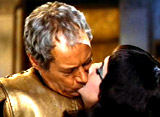  Cleopatra (Elizabeth Taylor) With Julius Caesar  Dancer  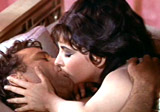 Cleopatra With Marc Antony |
||||||||||||||||||||||
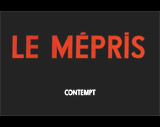
|
Contempt (1963, Fr./It.) (aka Le Mépris, or Il Disprezzo) New Wave film-maker Jean-Luc Godard's unrated European import with nudity further chipped away at censorship barriers. There were many views of the behind of its French starlet Brigitte Bardot. The marriage drama opened with an exploitative extended view of a fully nude Brigitte Bardot (as unsatisfied wife Camille Javal) lying face down in bed with her screenwriter husband Paul (Michel Piccoli). The scene - shot with a colored filter - was ordered to be added to the finished film by Italian producer Carlo Ponti, to capitalize on Bardot's immense popularity, although it desexualized the sex kitten with her questioning dialogue about all of her objectified body parts from her head to her feet:
The dialogue ended with her statement: "Then you love me totally." He answered: "I love you totally, tenderly, tragically." She replied, "Me too, Paul."
|
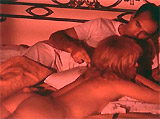 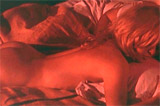   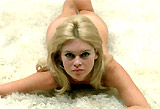 Camille (Brigitte Bardot) |
||||||||||||||||||||||
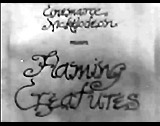
|
Experimental and openly gay filmmaker Jack Smith's controversial, ultra-low-budget 43 minute movie was declared obscene, sexually-graphic and depraved, and seized by police at its underground premiere in NYC in the spring of 1963. It was reported to be an exotic, Arabian tribute to 1940s screen star Maria Montez. The primitive, herky-jerky, ragged, over-exposed, and legendary film (shot on half-ruined or damaged film stock), made on a Greenwich Village rooftop in the city, was banned in 22 states and in four countries.
The many disjointed and odd-angled images of heavily-made-up lips, eyes, overlapping limbs, and genitals of bisexuals, transvestites, hermaphrodites and other drag queens (some in white fabric dresses), possibly in an Arabian harem - either dancing, grooming (primping), or romancing:
|
 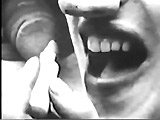 Lipstick Commercial 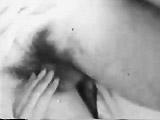 Male Nudity 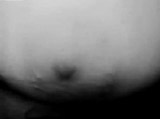 Close-Up of Jiggled Breast-Nipple 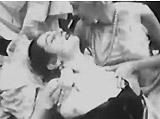   Posing During Arabian Harem Orgy |
||||||||||||||||||||||
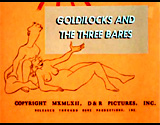
|
Goldilocks and the Three Bares (1963) This early, inaccurately-named Herschell Gordon Lewis (known later as the "Godfather of Gore") film was a further example of the predictable, usually awful "nudie-cutie" genre of films. It was considered the first nudie-musical (filmed in brightly-colored "Buffocolor" and "See-more-scope") - "the first (and to date the only) nudist musical." The film was created an excuse to display lots of female nudity (tops and back-end bottoms) in a naturist camp (mostly in the film's final 20 minutes only). The main attractions were blonde weekend naturist Allison Edwards (Allison Louise "Bunny" Downe) and other sun-worshipping nudists, highlighted by her ten-minute horseback (bareback) riding scene with friends (including lots of close-ups of bouncing breasts). There were other scenes of nudity, including naked pool frolics, casual nude lawn sunbathing, bare swinging on a hammock, nude water-skiing, and in-the-buff yachting.
In the plot, "skin-diving singing sensation" and comedian Eddie Livingston (Rex Marlow) became suspicious of his girlfriend Allison's mysterious weekend disappearances. He had a friend trail her, and she was followed into Sunshine Park, a Miami nudist camp. |
 Allison (Allison Louise Downe)  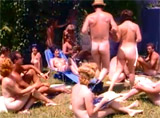 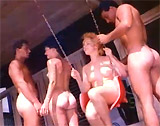 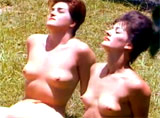
|
||||||||||||||||||||||
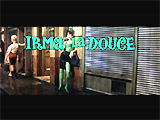
|
Irma La Douce (1963) Director Billy Wilder's bold and sexy French farce/romantic comedy, the biggest film of his career, was adapted from the successful 1960 Broadway stage musical, retaining only Andre Previn's Oscar-winning musical score. Because this was a Wilder film, it was filled with sexual double entendres, and it was a milestone Hollywood film featuring overt prostitution. The story told of fired gendarme Nestor Patou (Jack Lemmon), who struck up a friendship and romantic interest in a carefree, feisty Parisian streetwalker named Irma La Douce ("the sweet") (Best Actress-nominated Shirley MacLaine, although Marilyn Monroe was originally considered for the role). [In fact, MacLaine was presented as a seductive sex symbol in the film, with lots of barely-covered views of her breasts in a flimsy bodice.] Ultimately, he became her pimp (business manager or "mec") and then to monopolize all of her affections, impersonated a wealthy, buck-toothed, mustached, eye-patched British client named "Lord X" as her sole customer. However, complications arose when::
The film ended when Nestor 'killed' Lord X, and then became a prime suspect in Lord X's 'death' - culminating in a cathedral marriage with a very pregnant Irma. |
  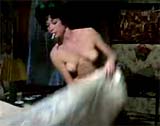 Irma La Douce (Shirley MacLaine) |
||||||||||||||||||||||
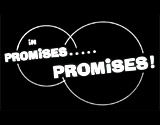
|
The buxom, platinum blonde sex goddess/siren Jayne Mansfield from the late 50s (a former Playboy Playmate in February 1955, similar to rival Marilyn Monroe), with a breathy and squeaky voice, appeared in such hits as The Girl Can't Help It (1956) and Will Success Spoil Rock Hunter? (1957). Then, Mansfield (measuring 40D-21-32) became the first mainstream actress to appear nude (not fully) in an American feature sound film, baring her breasts and buttocks. The film's poster shouted out Jayne's words:
The original version was banned in many cities (including Cleveland) and substituted with an edited version. In order to have the film available, it was distributed independent of the major studios. The provocative sexploitative film which emulated Howard Hawks' Gentlemen Prefer Blondes was heavily publicized (pre-release) in Playboy's June 1963 issue in a pictorial titled The Nudest Jayne Mansfield, with more revealing pictures to prove it, that led to the magazine's Chicago publisher Hugh Hefner being charged with obscenity (and later acquitted) -- the only time in his life. In this unrated sexploitation farce by director King Donovan, Jayne Mansfield played the notorious role of Sandy Brooks, taking a cruise with her eccentric and clueless, anxious, black-spectacled husband, TV script writer Jeff (Tommy Noonan), and desperately hoping to have a baby. He often took to drinking - psychologically fearing that he was infertile after 4 years of marriage. The ship's doctor (Fritz Feld) gave Jeff a placebo, but suggested that he was getting a Viagra-like pill to stimulate his manhood. The couple made friends with their neighboring shipmates, Claire (Marie McDonald, an ex-Miss New York) and her muscle-bound weightlifter/actor-husband King Banner (Mickey Hargitay, former Mr. Universe and Mansfield's real-life husband). After a night of drunken carousing, they realized - eventually, that the two females were pregnant, but by whom, since it was thought that Jeff was impotent (he admitted it happened when he had the mumps in military school - which would actually cause sterility!) - the film's running gag.
In the film's first few minutes, Mansfield wriggled in a foamy bathtub on board the ship and sang "I'm In Love," then toweled off (and dropped her towel) at the bathroom door to toplessly greet astonished husband Jeff with: "Do you want something, honey?...See ya later." She also suggestively writhed on a bed. Many of the 'nude' clips were repeated in the film, as short dreamy flashbacks. Its success led one of the film's actors, Tommy Noonan, to follow up a year later with 3 Nuts in Search of a Bolt (1964), featuring an unclothed Mamie Van Doren. |
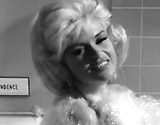  Sandy Brooks (Jayne Mansfield) 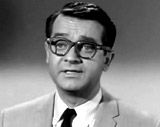 Jeff (Tommy Noonan) 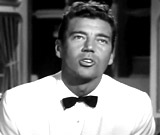 King Banner (Mickey Hargitay) 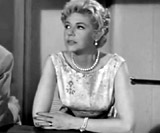 Claire (Marie McDonald) |
||||||||||||||||||||||

|
Scum of the Earth (1963) This was a 'dark' poorly-made early "roughie" film in the mid-1960s. It was directed by the notorious Herschell Gordon Lewis in his pre-gore days with his frequent producer David F. Friedman. The film was advertised as "Depraved, Demented, Loathsome, Nameless, and Shameless" and deliberately filmed in black and white to emphasize its sordid nature - it contained only limited hints of very tame nudity (very brief glimpses of breasts). It also stated:
In this expose of smut peddling and the pornography racket, wholesome and naively innocent, dark-haired high school beauty Kim Sherwood (Vickie Miles, aka Allison Louise Downe), was asked to pose for some 'glamour shots' by model Sandy (Sandra Sinclair), who was already modeling but wanted out of the business (by replacing herself with other models). Young college-bound Kim decided to model to earn money for her college tuition, and began to have her pictures taken by Sandy's photographer - the sleazy and boozing Harmon (William Kerwin, aka Thomas Sweetwood). However, it soon evolved into the degenerate world of the 'dirty picture' racket. Harmon was actually working with others to illegally sell the photos as part of a pornography ring. Kim was soon coerced into posing topless and her smutty photos were peddled to HS students by juvenile delinquent classmate Larry (Mal Arnold) - and it ruined her reputation. She was blackmailed into appearing in raunchier, more explicit porno shots ("If you don't go along with these morons, they're going to place your bosom all over this town!"). The film included an infamous, moralistic speech in which Kim was denounced by sleazy boss Mr. Lang (Lawrence Wood) - the head of the corrupt modeling agency, as the camera progressively zoomed into his mouth (revealing lots of metal crown-work):
Everything later led to three deaths (one with a baseball bat, and Lang killed his own assistant Larry), including a threatened belt whipping (and possible rape), and a climactic police raid. In the conclusion, Lang suicidally killed himself when he shot himself in the mouth, as he was pursued into the ocean by police. As he pulled the trigger, the screen turned blood red - in homage to Hitchcock's Spellbound (1945). |
  Sandy (Sandra Sinclair) 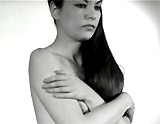 Kim (Vickie Miles)  Cindy (Christina Castel) 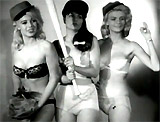 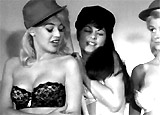
Cindy, Kim, Sandy |
||||||||||||||||||||||

|
The Silence (1963, Swe.) (aka
Tystnaden)
Writer/director Ingmar Bergman's last film of a trilogy about faith and redemption (preceded by Through A Glass Darkly (1961) and Winter Light (1963)) attracted unusual attention for its explicit and "overt sexuality" for its time (nudity, incest, self-defilement - female masturbation, nymphomania, and urination). It told about emotional emptiness, fractured intimacy, failed communication and distance in human relationships in its voyeuristic, bleak story of two polar-opposite, incestuous sisters, with a wide void between them:
While they traveled by train together to Sweden, they stopped in a nameless foreign Central European country and checked into the claustrophobic, deserted Hotel Europa, in "Timoka," where they rented a two-room apartment. The only bridging element between them was younger sister Anna’s innocent 10 year-old son Johan (Jorgen Lindstrom). While Ester remained in her hotel room - dying, Anna went looking for nihilistic pleasure in sex. She voyeuristically spied on a uninhibited couple making clothed love in an uncrowded, dark cabaret-revue theatre during a performance, and then had casual sex in a vacant church with a stranger - cafe waiter (Hakan Jahnberg). Afterwards, Anna told her sister details of her sexual encounter:
Although Ester begged her not to meet the man again, she met him for a second round of sex in one of the vacant hotel rooms. After sex, Anna told him: "How nice that we don't understand each other."
The climactic scene occurred when Ester entered the hotel room where her sister was having sex with the stranger. This precipitated a violent and bitter argument about their dislikes for each other. After Ester left, Anna expressed a range of emotions from deranged laughter to sobbing tears when she commenced love-making again with the man. The next morning while left alone, despairing, hopeless and knowing death was imminent, Ester intellectualized to herself:
Anna and Johan left on the 2 o'clock train, leaving Ester to die in her sweltering hotel room. |
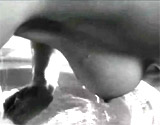 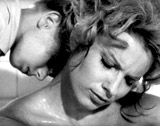 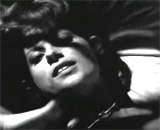  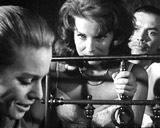 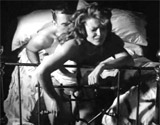
|
||||||||||||||||||||||

|
Tom Jones (1963, UK) This Best Picture of the year by director Tony Richardson was a costumed historical adaptation based on Henry Fielding's novel. Its most memorable and notable scene was the much-imitated, bawdy, extended-foreplay, primal food-eating sex scene between:
Meat, fruit, and oysters provided the aphrodisiac. It was a perfect combination of carnal sexual lust and food consumption. Their multi-course dinner meal consisted of soup, drafts of ale, turkey, oysters, pears, and wine which they slurped, sucked, and tore into with gleeful and pleasurable abandon. |
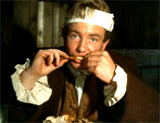 Tom Jones (Albert Finney)  Mrs. Waters (Joyce Redman) |
||||||||||||||||||||||
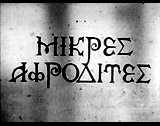
|
Young Aphrodites (1963, Greece) (aka Mikres Afrodites) Director Nikos Kounduros based his film on the Pastoral Idylles of Theocritus in the 3rd century, about the two nymphs - Daphnis and Chloe. There was some talk when the film was released about it being scandalous and inappropriate to have the two young leads often half-naked. However, the nudity was very brief and more suggestive in the film's advertising and marketing than in the actual film itself.
The coming-of-age story of mating and sexual awakening (with a tragic ending) opened in the year 200 BC. The two main young characters who engaged in courtship were:
There were two other parallel older characters who lived in a nearby fishing village:
|
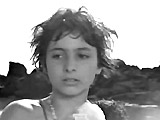 Chloe 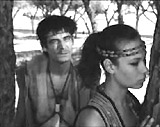 Tsakalos and Arta  Watching Tsakalos and Arta Having Sex in a Rock Cave |
||||||||||||||||||||||